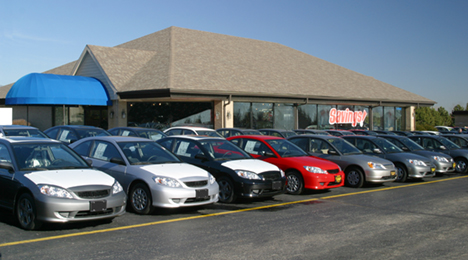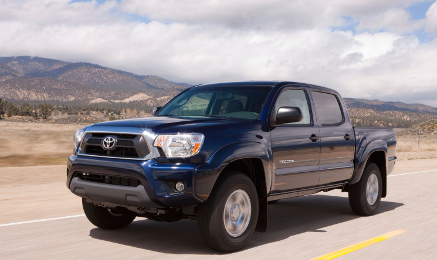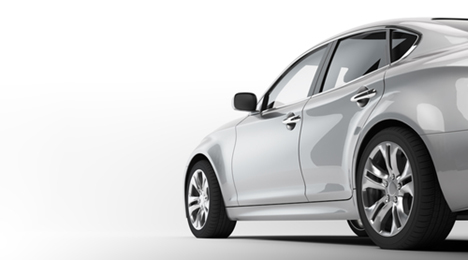Auction prices in Canada have remained mostly consistent in 2014 with slight fluctuation, but July told a bit of a different story, according to the ADESA Canada Used Vehicle Price Index.
The index, powered by ALG, fell substantially after being adjusted for seasonality, the company reported, dropping by an average of 0.8 percent month-over-month.
And most all segments saw a drop in price this past month.
In fact, midsize SUVs were the only segment to see prices rise, but the jump was significant. The segment saw prices spike by 2.5 percent, or $305, from June.
Interestingly, another van segment found itself at the other end of the spectrum.
According to the index, minivan prices fell at the fastest rate last month, falling by a whopping 10.4 percent, or $1,067, in July.
This segment was followed — though not closely — by the mid-compact cars, which saw prices drop by 4.7 percent, or $396.
Midsize cars were up next with a price decline of 4.3 percent, or $419.
Lastly, full-size pickups dropped by 1.8 percent ($333), and compact SUVs fell by 2.8 percent, or $343.
Used-car prices were on the way down in July, but new-vehicle sales were heading in the opposite direction, with a reported increase of 11.3 percent year-over-year. This performance marks the best July for new-car sales on record, ALG analysts pointed out.
Year-to-date, new-car sales are up 4.1 percent, a number that could bode well for trade-ins at dealerships, as used supply remains tight.
That said, relief could be on the horizon.
The latest RVI Risk Outlook report indicates that used-car supply will likely increase over the next five years. Consequently, within this time frame, used-car prices — on a nominal level — are predicted to drop by 4 percent from current levels by 2017.
And ALG predicts that between last month and July 2018, used supply will increase by 178,000 units. For more analysis from ALG, see the Auto Remarketing Canada story here.
After beginning to fall in May, wholesale prices turned down slightly this past month, as well.
The Manheim Canada June Used Vehicle Value Index was down 2.9 points from May, coming to rest at 96.0.
And though dealers may be seeing a bit of price relief in the lanes as we head into summer, prices are still up 9.3 points year-over-year.
That said, Don Wallace, general manager of Manheim Toronto, told Auto Remarketing Canada the auction market is trending toward normalcy.
“We’re starting to see a return to level of normalcy both in a more balanced buyer, seller market as well as consistent and sustained pricing seasonality, which has been somewhat absent from the Canadian market in the past several years,” he said.
In June, almost all segments saw prices fall month-over-month.
The biggest price declines were seen among compact cars, which dropped by 3.8 points on the Index.
SUVs weren’t far behind with a 3.7-point decline.
Luxury cars saw a decline of 2.9 points, equal to the overall average.
Rounding out the declines were midsize cars, which fell by 1.5 points; and the vans, which saw an average decline of 0.9 points.
The only segment to see an increase in price was the pickup truck, which saw a rise of 0.9 percent on the index.
Wallace pointed out that this segment is still feeling the impact of the leasing drop back in 2008.
“Good 3- to 5-year-old pre-owned pick-up trucks are still in very short supply as OEM lease penetration has significantly reduced from the peak in the previous decade,” Wallace explained.
As for what’s in store for the rest of this year, prices remain strong even as supply slowly expands — in other words, it’s a slow process.
“With moderate growth in the used-vehicle supply from both dealer trades and growing OEM off-lease inventories, we’d expect this gradual price softening to continue, albeit still relatively strong as the index would suggest,” Wallace concluded.
Though wholesale prices remain elevated, rates were on the way down in the lanes this past month.
In May, the Manheim Canada Used Vehicle Value Index was down four points from April to sit at 98.9.
Though rates are falling from early-spring highs, this number remains up 12 points year-over-year.
That said, Don Wallace, general manager at Manheim Toronto, told Auto Remarketing Canada, “The industry is seeing softening to the hyper-inflated used vehicle prices of 2013.
“The first quarter of 2014 has shown more traditional levels. Retail new volume generating the majority of the auction business through dealer trades is noticeably, as well,” Wallace said. “Prices have also been inflated due to U.S. buyers, or exports to U.S. by Canadian sellers, which have declined in the past quarter, as well.”
All vehicle categories Manheim Canada tracks decreased month-over-month.
When asked what is pushing the index down in 2014, Wallace said, “Several manufacturers have experienced shortages in new vehicle deliveries for the 2014 model year, but productions has now caught up to demand, influencing late model demand at auctions.”
Compacts led the way in May for price declines, with a 7.8 point decrease on the index.
This trend is primarily due to prices at the pump.
“Compacts have steadily declined in the past year as consumers have adapted to current pump prices. This has become the norm every time we see spikes in the price of gas after initial quick run ups,” Wallace explained.
Vans followed with a decrease of 5.1 points; mid-size cars fell by 4.9 points; luxury cars dropped by 3.6 points; and pickups dropped by 2.4 points.
The smallest price drops seen this month was in the SUV segment. These vehicles saw a drop of 1.4 points on the index.
“Pickups are still in very short supply. SUVs are tied to gas again where the buyers have been acclimatized to current price at the pump,” Wallace said.
Looking ahead to the rest of the year, Wallace said, “Time will tell,” but he predicts incentive movement might serve to push prices down further.
“I suspect more micro-economic factors affecting new vehicles sales will drive OEM’s to adjust incentives to maintain sales volume, which will have a bigger effect on used vehicle pricing than economic conditions,” he said. “If one or more of the top sellers’ sales decline through the summer months then we can expect aggressive incentive spending to recapture business. Heavy incentive spending, which has been on the decline, would adversely affect used car prices. Seasonal prices are also expected to normalize to traditional adjustments.”
Though relief from high prices at auction is almost visible on the horizon, according to industry predictions, dealers are still having to shell out for quality used vehicles in the lanes, at least for the short term.
According to RVI’s Q1 report, in March, used-car prices at auction rose by 2.8 percent from February and a significant 9.5 percent from March of 2013.
After adjusting for MSRP, the jump was still high, with a 1.1 percent spike from February and a 3.8 percent year-over-year increase.
And dealers are in for a few more months of such increases, as RVI officials said, “Used-car prices are expected to increase for the near future.”
When compared to March of 2013, sub-compacts, compacts and minivans saw the biggest price increases at auction during Q1.
Minivans led the pack with a year-over-year price increase of 17.3 percent.
Sub-compacts followed with an increase of 12.7 percent year-over-year, and compact prices rose by 10.3 percent.
These high numbers might be here to stay for quite a while, as RVI isn’t predicting prices to drop until 2016.
“Beginning in 2016, used-car prices will decline through 2019, falling below current levels,” the company said.
According to RVI, these price drops will be due largely to “increases in the supply of used vehicles and more competition among car manufacturers,” both of which will serve to put downward pressure on used-vehicle prices.
Used-vehicle supply is expected to start increasing this year and continue rising through 2019.
According to RVI’s Used Vehicle Stock Index, supply is currently up 1.2 percent from 2013 rates, and used supply will expand 2.9 percent in 2015 versus this year.
After rising 0.4 percent in February, wholesale prices remained flat in March, slowing the consistent auction price spikes seen in 2013.
The ADESA Canada Used Vehicle Price Index, powered by ALG, was flat after being adjusted for seasonality, and wholesale prices were unchanged month-over-month.
The segments that did see price movement were a mixed bag.
Compact SUVs saw prices rise the most, increasing by 4.2 percent or $545.
The segment was followed by midsize cars with a 3.8 percent or $387 increase and minivans with a 0.9 percent or $95 spike.
On the other hand, mid compact cars saw the biggest drop last month, declining by 3.3 percent or $310.
And as weather warmed, consumers are turning interest away from winter-weather vehicles, as midsize SUVs saw prices drip by 1.3 percent or $175, and full-size pickup prices fell by 1.2 percent or $238.
Dealers can only hope this flattening of wholesale price movement is a sign of what’s to come for the rest of 2014.
According to ALG Canada’s latest industry report released in late February, used-vehicle prices have risen steadily by 3.5 percent on an annual basis since mid-2009.
But this year, used-vehicle prices are expected to decline in the range of 4 percent to 5 percent, according to ALG Canada.
The company broke down the trends by vehicle age, as well, since not all used vehicles are expected to experience the average drop this year.
Prices will be strongest among 3- to 4-year-old vehicles, according to the report, which said these vehicles will be in short supply for another two years.
On the other hand, there will be an above-average supply of 5- to 7-year-old vehicles available over the same period, placing downward pressure on prices for this vehicle-age group, reports ALG Canada regional director Geoff Helby.
As for the younger units, due to fleet sales gaining momentum, ALG Canada predicts the supply of 1- to 2-year-old models will expand to above average levels this year, which will play a part in making these rides more affordable, as well.
Lastly, Helby pointed out that new-vehicle incentives remain at record-high levels and will “dramatically reduce” price gains for 1-year-old vehicles.
Though many are predicting supply to loosen a bit this year, causing used prices to slide, pre-owned prices aren’t quite there yet as seasonality comes into play.
Used values are still pushing up as spring approaches, and the ADESA Canada Used Vehicle Price Index, powered by ALG, rose by 0.4 percent in February.
Price spikes were positive for nearly all segments last month.
Interestingly, after experiencing a sharp decline in January, midsize SUV prices rose at the fastest rate last month, increasing by 8 percent (or $986), according to the Index.
The segment was followed by mid-compact cars with a 6.1-percent ($536) hike; meanwhile, full-size pickups rose by 2.0 percent ($389), minivans by 1.1 percent ($114) and compact SUVs by 0.9 percent ($120).
Midsize cars were the only segment with lower prices last month, according to ADESA data, falling 0.6 percent ($66).
Though price increases aren’t slowing yet, analysts are beginning to predict expanding supply may provide downward pressure in the near future.
According to ALG Canada’s latest industry report, used-vehicle prices have risen steadily by 3.5 percent on an annual basis since mid-2009.
But this year, used-vehicle prices are expected to decline in the range of 4 percent to 5 percent, according to ALG Canada.
The company broke down the trends by vehicle age, as well, since not all used vehicles are expected to experience the average drop this year.
Prices will be strongest among 3- to 4-year-old vehicles, according to the report, which said these vehicles will be in short supply for another two years.
On the other hand, there will be an above-average supply of 5- to 7-year-old vehicles available over the same period, placing downward pressure on prices for this vehicle-age group, reports ALG Canada regional director Geoff Helby.
As for the younger units, due to fleet sales gaining momentum, ALG Canada predicts the supply of 1- to 2-year-old models will expand to above average levels this year, which will play a part in making these rides more affordable, as well.
Lastly, Helby pointed out that new-vehicle incentives remain at record-high levels and will “dramatically reduce” price gains for 1-year-old vehicles.
Editor’s Note: For more market intelligence on used supply and pre-owned prices, see the March/April edition of Auto Remarketing Canada Digital Magazine.
Prices for used cars were on the way down as 2014 got underway — a trend rarely seen in Canada since the 2008 economic downturn that caused leasing to fall off, leading to extremely tight pre-owned supply
This past January, prices for 2- to 5-year-old vehicles fell by 2.1 percent from December, according to RVI Group’s latest Market Update.
That said, prices are still up quite a bit over 2013 rates at this time. According to RVI Group, prices were up by 6.7 percent in January when compared to the same period of 2013.
According to RVI, though most segments saw declines, a few are bucking the trend with fairly significant price growth.
There were a few outliers, as the minivans and subcompacts saw the biggest increases this past month, with price hikes of 10.1 percent and 8.2 percent, respectively.
The ADESA Canada Used Vehicle Price Index also fell this past month after being adjusted for seasonality. According to the index, wholesale prices declined on average by 0.5 percent month-over-month in January.
Price movement was a bit of a mixed bag, according to ADESA Analytical services, ranging from increases of more than 10 percent to drops as high as 24 percent.
The biggest percentage increase was seen in the mid-compact car segment, which grew by 11.5 percent (or $905).
Midsize cars also touted a significant price hike last month, rising by 9.8 percent (or $908).
Minivans, with a 6.6-percent increase ($627), and full-size pickups, which jumped 3.9 percent ($711), wrap up January’s big climbers.
On the other hand, midsize SUVs declined substantially, falling 24.2 percent ($3,912), while compact SUV prices fell 2.8 percent ($366).
CanadianBlackBook.com today released the results of its annual “Best Retained Value” winners across 19 vehicle categories.
Once again, Toyota continued its streak of awards, taking first in the small pickup (Toyota Tacoma) and full-size pickup (Toyota Tundra) segments for the fifth straight year; and for the fourth consecutive time in the mid-size SUV (Toyota FJ Cruiser) and full-size SUV (Toyota Sequoia) categories.
The awards track vehicle values over a four-year period, so this year’s set measures how well 2010 model-year vehicles have held their value through December 2013.
CanadianBlackBook.com names first-, second- and third-place “Best Retained Value” award winners in 19 popular car and truck categories.
Toyota’s Prius, Avalon, Tacoma, Tundra, FJ Cruiser, Sequoia and the Lexus GS, all posted first-place finishes.
Among domestics, Chrysler chalked up the best performance, with Jeep Wrangler winning compact SUV for the fourth straight year; and the Challenger winning in the sports car category for the third year in a row.
And two first-place finishes each by Porsche and Mercedes helped European manufacturers double the number of awards secured this year compared to 2013.
When asked why Toyota continues to do so well with retention rates, Josh Bailey, vice president, research and editorial at Canadian Black Book, said it comes down to the automaker’s reputation for quality — despite dealing with multiple recalls in the past five years.
“I think an element of it is certainly Toyota has a reputation for quality, I know they have been through a few recall situations lately … but I do think they handle those problems well,” Bailey said. “Talking to people who actually own the vehicles and take it out of the headline context, people walk away from the experience more confident than they were going into it because the automaker handles these issues so well.”
Toyota is also very careful not to over saturate their markets, which in turn leads to strong retention rates.
“I also think that there is a scarcity factor. When we look at several of the winners, they often tend to be lower volume. And comparing Tundras to the domestic pick-up trucks, certainly there is a scarcity factor there. And I think that keeps the values relatively strong. And Toyota doesn’t typically pour too much in the way of cash incentives on those trucks either,” Bailey explained.
CanadianBlackBook.com analysts explained that “consistency” is the theme for the 2014 awards.
On top of Toyota’s winning streak, Chrysler (Jeep Wrangler, compact SUV segment) , Honda (Honda Fit, subcompact car; and Honda Odyssey, minivan) and Subaru (Subaru Outback, mid-size car) also racked up repeat first-place finishes, all for at least three years running.
“Although CanadianBlackBook.com proclaims the winners, in effect, it’s the Canadian car buyer who decides who wins our Best Retained Value awards,” said Bailey. “In the end, it is consumer perceptions and how much they’re prepared to pay for cars and trucks that ultimately determines how much a vehicle is worth.”
The Outliers
Consistency was the name of the game this year around, but there were a couple of outliers among the award winners, as well.
One of these outliers continues to be the Toyota Prius, as most of its alternative-fuel counterparts continue to lose value.
The Toyota Prius won first place in the compact car category, with the Volkswagen Golf and Subaru Impreza following, respectively.
When asked why the Toyota Prius continues to stand out from its hybrid competitors, Bailey said, the fact that it stands on its own is a big plus for retention rates.
“I found that hybrids where they are unique product tend to stand out and do better in terms of retaining value. While ones that are more part of a comprehensive platform program, like Camry or Altima, they have hybrids as an element, but they tend to get washed away,” Bailey explained.
One of the reasons might also be price: when compared to the traditional fuel option, models like the Honda Civic Hybrid might get overlooked due to their higher price tags.
“When it comes to Altima and Camry, and anything else that has a hybrid option, they need to go after the volume of the price point of where people are buying. Most of the time, they hybrids sit just right above the common price point, so we don’t see people pursue those as strongly as something like a Prius,” Bailey said.
Another outlier this year is the following surprise winner: the Hummer H2, which delivered the highest retained value percentage of all vehicles for 2014.
It topped the list, retaining 71 percent of its original MRSP after four years of ownership.
“Its value actually increased last year, so it’s bit of an anomaly,” says Bailey. “The vehicle is now out of production which is contributing to its desirability.”
“It is remarkable when I see a Hummer H2 at auction, it is almost certainly going to draw a crowd, almost regardless of mileage, repair history, etc. I have a feeling that a lot of them are getting purchases and then shipped overseas,” Bailey said.
Scarcity may also be a playing a role.
“They were never sold in large volumes to begin with … but I think as they are leaving the market completely, it is creating a vacuum. There still seems to be enough people that want to be rolling around in their Hummer,” Bailey said.
European Automakers Double Award Wins
Lastly, Bailey touched on how the European brands managed to double their award count this year.
Though that only brings the European automakers up to four awards, it still represents a big jump from last year. The newcomer’s awards are due to a couple of new units becoming eligible this year.
“Because we are looking at 4-year-old vehicles, this is the first chance for the Porsche Panamera to show up on the list, so I think the volume is fairly small again versus the S Class, but there is still a demand in the used-car market,” Bailey said. “Comparing the 2010 and 2014, we might recognize the differences, but to the average Joe, he could probably pass it off as a new one.”
And for Mercedes-Benz, this was the first year the GLK was eligible, and it has done very well, says Bailey.
“It really is in high demand. There really isn’t a shortage of those, so the strong retention rates really speak to how many people are looking for these models in the used-car market,” he added.
A full listing of this year’s winners, along with previous winners can be found on CanadianBlackBook.com.
After rising during most of last year, used-car prices continued their upward trek during the last month of 2013, climbing by 2.5 percent on a monthly basis. And though used-vehicle prices rose by 4.3 percent in December on a year-over-year basis, RVI provided some good news for the future in its latest RVI Risk Outlook.
Though dealers will have to suffer through a few more years of high auction prices, a turning of the tides may be in sight.
Used-car prices are expected to see year-over-year declines starting in 2015, and are predicted to decline around 1.6 percent from current levels through 2017, according to RVI data.
Here’s the outlook from RVI for the next few years:
Used-car rates are expected to remain strong through 2014 as exchange rates are expected to remain lower than the past few years.
“As the U.S. Federal Reserve began scaling back its stimulus spending in January, expressing confidence in the U.S economy, exchange rates began falling,” RVI analysts said.
As of Jan. 28, exchange rates were at $0.897 US/$CAN.
Looking forward, RVI explained that used-vehicle supply is expected to increase through 2019, which will serve to put downward pressure on used-car prices.
“Although a lower forecasted exchange rate has a positive effect on used-car prices, the increasing used vehicle supply will still result in lower used-car prices,” analysts said.
These predictions might act as consolation to dealers who are in for another year of strong wholesale prices, according to ADESA’s chief economist Tom Kontos.
In the U.S., the end of 2013 coincided with a loosening of used supply, due in part to an influx of off-lease vehicles, and consequently, lower prices in the lanes.
Kontos said Canadians are on track to enjoy the same relief — just not yet.
He explained that Canada is “lagging” behind the U.S. in terms of recession recovery for the used market.
“The main point is the off-lease volume, and volumes in general, is at a low point right now (in Canada). The supply is low, which is keeping prices relatively strong in the wholesale market,” Kontos said, explaining that the U.S experienced the same struggle during the 2010–2012 period.
Only in late 2013 did the U.S. begin to see recovery in off-lease volumes.
“In Canada, the recovery in supply is not expected to be felt until beyond 2014. So, 2014 looks to be another year of relatively strong wholesale values,” Kontos said. “Canada is still going through the period of tight supply, which is holding up used-car values.
During the last month of 2013, wholesale prices did rise on an overall basis — a trend dealers experienced during most of last year — but the spike was slight, and price movements for most segments were negative.
According to the ADESA Canada Used Vehicle Price Index, powered by ALG, wholesale prices rose by an average of 0.2 percent month-over-month in December.
This rise contributed to an overall 4-percent increase in wholesale prices for 2013, according to ADESA Analytical Services.
But despite the slight uptick in December, price movements were negative for most segments during December.
Midsize cars declined at the fastest rate, perhaps not surprising as winter weather takes hold. This segment fell by 5.9 percent or $473.
The midsize cars were following by the mid-compact cars (down 5.9 percent or $365), fullsize pickups (down 2.3 percent or $334) and compact SUVs (down 2.1 percent or $232).
Among the segments that saw increases was one dramatic market correction.
The minivan segment corrected after declining dramatically in November, according to the Index, rising by 20.5 percent ($1,301), while midsize SUVS also increased by 2.5 percent ($349)












